Click on images to enlarge
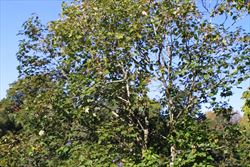
habit (Photo: Trevor James)
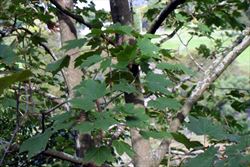
main trunk and branches (Photo: Trevor James)
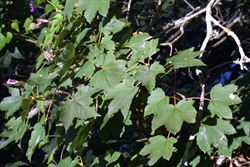
bright green leaves during spring (Photo: Trevor James)
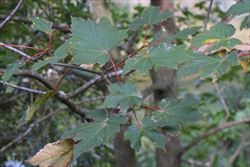
each leaf has a reddish stalk and 3-5 lobes with coarsely toothed margins (Photo: Trevor James)
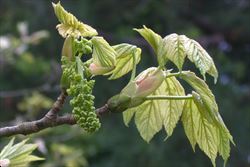
young leaves and flower cluster in early spring (Photo: Rob and Fiona Richardson)
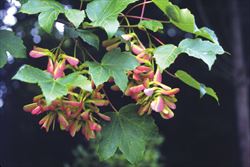
clusters of immature fruit, which are often reddish-tinged, during spring (Photo: Trevor James)
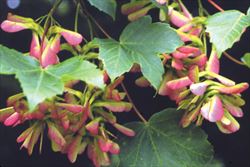
the fruit consist of two samaras that are joined together near the base (Photo: Trevor James)
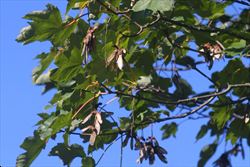
mature fruit during summer (Photo: Trevor James)
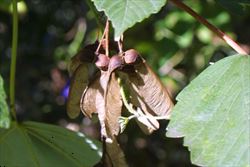
close-up of mature fruit, with wings that are prominently veined (Photo: Trevor James)
Scientific Name
Acer pseudoplatanus L.
Synonyms
Acer pseudo-platanus L.
Family
Aceraceae
Common Names
dool tree, erable sycamore, great maple, grief tree, hanging tree, joug tree, maple, planetree maple, purple sycamore, Scottish maple, sycamore, sycamore maple, whistlewood
Origin
Originating from the mountainous parts of southern and central Europe, and also native to the Caucasus mountains in central Asia (i.e. Turkey, Georgia and Russia).
Cultivation
Sycamore maple (Acer pseudoplatanus) is widely cultivated and is a popular garden ornamental in the cooler parts of south-eastern Australia. Numerous cultivars and varieties of this species are commercially available in Australia.
Some of the most well known include purple-leaf sycamore (variously known as Acer pseudoplatanus var. purpureum, Acer pseudoplatanus 'Purpureum', Acer pseudoplatanus 'Atropurpureum' or Acer pseudoplatanus 'Spaethii') and variegated sycamore (Acer pseudoplatanus 'Leopoldii'). Other cultivars include 'Brilliantissimum', 'Nizetii', 'Variegatum', 'Erythrocarpum', 'Rubicundrum', 'Bruchem', 'Erectum', 'Prinz Handjeryi' and 'Tricolor'.
Naturalised Distribution
Naturalised in eastern New South Wales, southern Victoria and south-eastern South Australia. Also thought to be naturalised in Tasmania, though this has yet to be ratified by herbarium specimens.
Sycamore maple (Acer pseudoplatanus) is most widespread in Victoria, where it has been recorded in numerous sites including several conservation areas. These include the Grampians National Park, the Alpine National Park in the north-east of the state, and the Ferntree Gully National Park in the suburbs of Melbourne. In New South Wales it has been recorded near Jenolan on the central tablelands west of Sydney and in South Australia scattered outbreaks have been found in the Adelaide Hills. It is scattered in north-eastern Tasmania and has also been recorded at Taroona, near the Derwent River, in southern Hobart.
Sycamore maple (Acer pseudoplatanus) has also become naturalised in many other parts of the world including New Zealand, northern Europe, the United Kingdom, Madeira, the Canary Islands, temperate Asia, Chile and North America (i.e. parts of north-eastern USA and Canada).
Habitat
In Australia, sycamore maple (Acer pseudoplatanus) grows in tall wet forests (e.g. wet sclerophyll forests), along waterways (i.e. in riparian vegetation), and in gardens in wetter temperate regions.
In New Zealand this species grows in abandoned gardens, in wastelands, along roadsides, along waterways and in forests.
Habit
A moderately-sized to large tree with a spreading crown usually growing 12-25 m tall, but occasionally reaching up to 35 m in height. It loses all of its leaves during autumn and winter, and new foliage emerges each spring (i.e. it is deciduous).
Distinguishing Features
- a medium-sized to large tree with oppositely arranged simple leaves.
- its leaves are shaped like a hand, with 3-5 deep lobes that have toothed margins.
- separate male and bisexual flowers usually borne on the same plant.
- these inconspicuous flowers are borne in branched or un-branched hanging clusters at the tips of the stems.
- its relatively large v-shaped fruit (3-5.5 cm long) consist of two prominently winged 'seeds' that are joined together at the base.
Seedling
Seedlings have two seed-leaves (i.e. cotyledons) that are somewhat elongated (i.e. lanceolate) or oblong in shape. The first pair of true leaves are usually simple and have sharply-toothed (i.e. serrated) margins. As the seedlings grow they develop leaves with three, and then later five, deep lobes.
Stems and Leaves
The trunks and branches of younger trees are covered with a smooth grey bark, while the bark of older trees becomes scaly. Older trunks sometimes have a reddish-brown or orange-brown colour where the scaly bark flakes off. The wood of this species is very pale, being cream to almost white in colour. The younger branches and growing tips are smooth, hairless (i.e. glabrous) and green or reddish-green in colour. Dormant growing buds are present at the tips of the branches during winter, and these have several overlapping scales (about 6 mm long) that are usually green in colour.
The large leathery leaves (7-30 cm long and 8-22 cm wide) of this species are oppositely arranged along the stems. These leaves are divided into 3-5 broad lobes (usually five) which are cut about halfway to the base of the leaf and resemble the fingers of a hand (i.e. they are palmately lobed). They are hairless (i.e. glabrous), borne on long reddish-green stalks (i.e. petioles) 3-15 cm long, and have coarsely toothed (i.e. serrate) margins. The upper surfaces of the leaves are usually dark green or occasionally bluish-green (i.e. glaucous) in colour and their undersides are lighter green and/or with a reddish or purplish tinge (particularly near the prominent veins). Leaves gradually change colour as they age and eventually turn yellowish or brownish before being shed during autumn and winter.
Flowers and Fruit
The inconspicuous flowers appear with or after the first leaves each spring. Separate male (i.e. unisexual) and bisexual flowers are usually borne on the same plant (i.e. this species is andromonoecious). These flowers are greenish or greenish-yellow in colour and relatively small (about 6 mm across). They have five tiny sepals and five very small oblong petals (2-4 mm long) that are similar in appearance to the sepals (i.e. they are sepaloid). Each flower also has 8-10 stamens and is borne on a slender stalk (i.e. pedicel) 3-8 mm long. They are arranged in branched or un-branched drooping clusters at the tips of the branches (i.e. in terminal racemes or racemose panicles). These inflorescences (5-20 cm long) contain 50-100 flowers and usually have hairy branches. As mentioned earlier, flowering occurs during spring (i.e. from September to November).
The distinctive v-shaped fruit (3.5-5.5 cm long) are borne in drooping clusters and each fruit consists of two one-seeded structures that are prominently winged (i.e. a special type of mericarp called a samara). They are joined together near the base to form a 'double samara'. The seed compartment at the base of these structures is nearly round (i.e. spherical) in shape and 5-10 mm long, while the wings are 2-4 cm long and prominently veined. Immature fruit are green or reddish-green in colour but turn brown in colour as they mature. They mature on the tree over summer and autumn (i.e. from December to May). The relatively large seeds are about 5-10 mm long.
Reproduction and Dispersal
This species reproduces by seed, the germination of which usually occurs in great numbers each spring. Plants will also re-shoot vigorously (i.e. coppice) when the top growth in removed or damaged.
The winged fruit are designed to be dispersed by the wind, and they usually rotate in a propeller-like motion as they fall to the ground. These relatively light fruit are also spread by water, and possibly by birds and other animals. The seeds may also be dispersed in dumped garden waste and as a contaminant of chipped prunings that are used as garden mulch.
Environmental Impact
Sycamore maple (Acer pseudoplatanus) is regarded as an environmental weed in Victoria, New South Wales and Tasmania. In other wetter temperate regions of Australia, where it is not yet well established, it is best described as a "sleeper weed" due to its potential to become a serious environmental weed in these areas.
This fast-growing species has become invasive in open woodlands, forests and along waterways (i.e. in riparian areas) in the temperate regions of Australia in recent years. It competes with native tree species, especially in riparian vegetation and wet sclerophyll forests, and is usually associated with high rainfall areas. Sycamore maple (Acer pseudoplatanus) can become established in disturbed and intact bushland, but in intact forests it is primarily a coloniser of gaps in the vegetation, even though its seeds can germinate in dense shade. When fully established in an area it can significantly reduce the light levels reaching the forest floor, thereby affecting the vigour and diversity of the native ground flora. Dense stands can crowd out native shrubs and trees and the enormous leaf drop that occurs during autumn and winter can impede the recruitment of indigenous vegetation (i.e. the dense accumulation of litter impedes the establishment of native species and further reduces the diversity of the site).
Populations of sycamore maple (Acer pseudoplatanus) are currently scattered, but it is becoming more and more common. The main infestations are in Victoria, and it is included on several environmental weed lists in this state (i.e. in Knox City, in the Goulburn Broken Catchment and in Sherbrooke Forest). It has also invaded coservation areas in southern Victoria (i.e. the Dandenong Ranges National Park and the Tarra-Bulga National Park) and is one of several exotic weed species that has become naturalised at Mt. Buller.
In Tasmania it is listed as one of the major environmental weed species managed by community groups associated with the 'Australian Trust for Conservation Volunteers'. It is primarily a weed of sclerophyll forests in Tasmania and is also known to be present in bushland that fringes the Derwent River (i.e. at Taroona in the southern suburbs of Hobart). Sycamore maple (Acer pseudoplatanus ) is also becoming a problem in the Blue Mountains region on the central tablelands of New South Wales (e.g. at Jenolan Caves).
Other Impacts
The winged seeds of this species readily germinate and may become a nuisance in gardens as well as nearby bushland reserves.
Legislation
Sycamore maple (Acer pseudoplatanus) is not declared or considered noxious by any state or territory government in Australia.
Management
For information on the management of this species see the following resources:
- Muyt (2001), Bush Invaders of South-east Australia, pp. 231-232.
Similar Species
Sycamore maple (Acer pseudoplatanus) may be confused with some other weedy introduced species including box elder (Acer negundo), Japanese maple (Acer palmatum), Norway maple (Acer platanoides) and London plane (Platanus x acerifolia). These species can be distinguished by the following differences:
- sycamore maple (Acer pseudoplatanus) has simple leaves with 3-5 deep and relatively broad lobes that resemble the fingers on a hand (i.e. they are palmately lobed). The leaf margins are also usually irregularly toothed (i.e. serrate). Its relatively large v-shaped fruit (30-55 mm long) consist of two one-seeded, and prominently winged, structures (i.e. samaras) that are joined together near the base.
- box elder (Acer negundo) has compound (i.e. pinnate) leaves with 3-9 relatively broad leaflets. The margins of the leaflets may be toothed (i.e. crenate or serrate) or slightly lobed. Its v-shaped fruit (30-40 mm long) consist of two one-seeded, and prominently winged, structures (i.e. samaras) that are joined together near the base.
- Japanese maple (Acer palmatum) has simple leaves with 5-7 very deep relatively narrow lobes that resemble the fingers on a hand (i.e. they are palmately lobed). The leaf margins are also usually irregularly toothed (i.e. serrate). Its relatively small v-shaped fruit (15-25 mm long) consist of two one-seeded, and prominently winged, structures (i.e. samaras) that are joined together near the base.
- Norway maple (Acer platanoides) has simple leaves with 5-7 deep and relatively broad lobes that resemble the fingers on a hand (i.e. they are palmately lobed). The leaf margins are also irregularly and deeply toothed (i.e. serrate). Its relatively large fruit (35-50 mm long) consist of two one-seeded, and prominently winged, structures (i.e. samaras) that are joined together near the base. Its leaves and younger stems exude a milky-white sap (i.e. latex) when damaged.
- London plane (Platanus x acerifolia) has simple leaves with 3-5 deep and relatively broad lobes that resemble the fingers on a hand (i.e. they are palmately lobed). The leaf margins are also usually irregularly toothed (i.e. serrate). Its rounded fruit (about 25 mm across) do not have any wings and usually two of these are borne on each stalk (i.e. peduncle).
In addition there are a few closely related natives called whitewoods (Atalaya spp.) and booyongs (Argyrodendron spp.) that have very similar winged fruit (i.e. double samaras). However, these species can be easily distinguished by their compound (i.e. pinnate or palmate) leaves, which usually have leaflets with entire margins. They also generally retain their leaves all-year-round (i.e. they are not deciduous).

